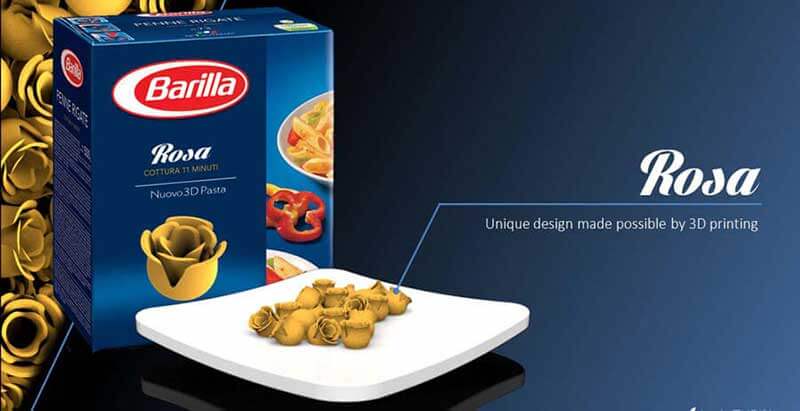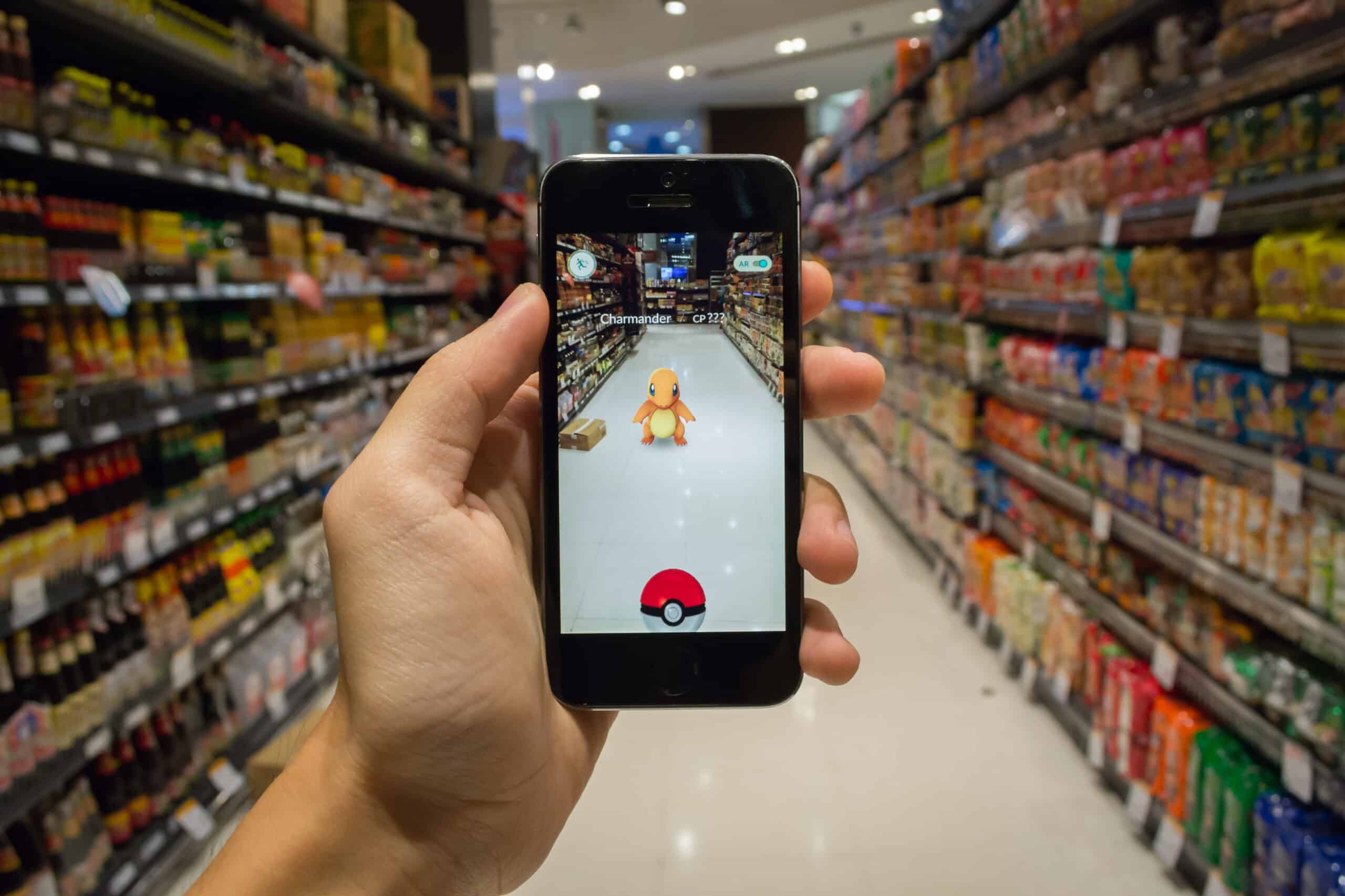- Tired of elbows, fusilli, penne and wagon wheels? Introducing 3D printed pasta by Barilla
- From drab pureed meals to enjoyable SmoothFood for senior citizens
- BeeHex robot prints a pizza in less than four minutes
- The Foodini food printer turns your kitchen into a haute cuisine restaurant
- Food Ink pop up restaurant: taking fine dining to crazy new levels
- 3D printing artificial protein a solution to the nightmare that is the meat industry?
There are countless applications for 3D printing within industries such as manufacturing, healthcare and many others but who would have thought we’d be 3D printing our food as well? Supermarkets are already testing customised, 3D printed cakes and desserts while restaurants serving 3D printed food are also starting to pop up. 3D printing technology is fundamental to the way we interact with food in the future and some even say we’ll all have 3D food printers in our homes within a few years.
Tired of elbows, fusilli, penne and wagon wheels? Introducing 3D printed pasta by Barilla
Italian cuisine giant and pasta maker Barilla, in collaboration with the Dutch research centre TNO, recently brought some variety in the pasta shapes that are available today. At the CIBUS 2016 International Food Exhibition in Parma this year, they launched their latest 3D printer that is able to create the most intricate pasta shapes imaginable. Think rocket ships and roses and everything in between. The pasta is made with water and durum wheat flour and printed with a pasta dough cartridge system. Currently, the printer –which has been in development over the past four years- can spit out roughly two pieces of pasta per minute but Barilla is working on increasing that speed to at least a portion every minute. All you have to do is choose a shape from the pasta library on your iPad or create your own pattern, send the data to the printer, load the cartridge with your favourite ingredients and print. Barilla aims at supplying a wide range of customers with their printer, such as pasta stores and restaurants. They are even talking about bringing the tech to home kitchens.

From drab pureed meals to enjoyable SmoothFood for senior citizens
In order to create more enjoyable meals for the thousands of senior European citizens who have chewing and swallowing difficulties and are therefore unable to eat normal food, Biozoon Food Innovations recently developed a new 3D printing technique. They prepare a paste from fresh ingredients such as carrots and chicken, mix it with an edible adhesive and then 3D print the paste into the shape of the original ingredient, such as a drumstick. SmoothFood is already being enjoyed by many seniors in old age homes all over Germany. The company aims to produce personalised food by using data files that determine the size of the portion or the vitamin and mineral content best suited to the person in question. SmoothFood can be used in facilities such as care homes, clinics and private homes and can play an important role in the fight against malnutrition among the elderly.
BeeHex robot prints a pizza in less than four minutes
The BeeHex was launched in 2015 by engineer Anjan Contractor who built NASA’s first 3D food printer for manned missions to Mars. In collaboration with attorney Ben Feltner, entrepreneur Jordan French and electrical engineer Chintan Kanuga, Contractor now builds 3D printing robots that automate the production of fresh food such as pizzas. The famous Ribalta restaurant chain in New York and Atlanta is in the process of employing some of these BeeHex robotic pizza chefs. Pasquale Cozzolino, executive chef, partner and founder of Ribalta, is convinced that 3D printing pizza will do great things for his restaurant chain. He believes that they will match some of the very best pizza makers in the country in terms of taste and quality and the BeeHex can print pizza in any shape within four minutes. Cozzolino will also serve as an advisor to oversee the recipes for the dough, cheese and sauce used in the BeeHex printers. The machines are still somewhat of a novelty and are mainly used at events but the aim is to start supplying big venues and sports stadiums with the printers soon.
The Foodini food printer turns your kitchen into a haute cuisine restaurant
There are food-capable 3D printers and then there are food-capable 3D printers and Foodini definitely takes the cake. Unlike other printers, the Foodini is capable of printing a wide variety of foods, ranging from chocolates and mashed potato to burgers, quiche, cookies and crisps. The aesthetically pleasing Foodini is basically a small food manufacturing appliance that squeezes out ingredients into pre-programmed shapes. The prints can be made up to several centimeters high or thick, enabling the machine to create some rather elaborate designs. The Foodini is dubbed the ‘Internet of Things’ appliance, as it can download various designs and recipes from the Internet. The Foodini enables chefs to create dishes that even the most capable of chefs hands are incapable of creating. It also makes automation easy as pie. Imagine, for instance, having to create one hundred heart-shaped breadsticks for people seated at tables at your restaurant. Instead of doing this all by hand, the Foodini can do it automatically, and to perfection. This nifty machine currently only prints food but the new generation Foodinis will also cook the food, making it the perfect appliance for every kitchen.
Food Ink pop up restaurant: taking fine dining to crazy new levels
The next in a growing line of hip and happening eateries is the Food Ink pop up restaurant in London where everything, from the furniture and the lamps to the cutlery and even the food, is 3D printed. Food Ink’s mission is to explore the overlap between tech-enhanced user experience and fine dining and use the universal language of food to show what is possible with 3D printing. For no less than £250 per person, the restaurant offers a nine-course menu, printed from a paste. According to Food Ink, technology needs to serve a purpose and they are using it to ‘add magic to the magic’. In order to provide an exquisite interactive culinary experience, guests do not only get to taste the intricately designed, 3D printed food, their experience is enhanced with virtual reality headsets and music composed by artificial intelligence. One of their missions is to provide a platform for conversations around how emerging technology changes the way we create, share and indeed, eat. We think their mission’s accomplished.
3D printing artificial protein a solution to the nightmare that is the meat industry?
Brooklyn-based startup Modern Meadow has more than a dozen patents and uses collagen-producing skin cells to create leather. In a process called biofabrication, the collagen protein, which is found in the connective tissues of animals, is used to produce fully biological leather that is hair-, fat- and blemish-free. No animals are harmed in the process as only some skin cells are harvested. Eventually, the company will also look into creating healthy and ethical meat products. The biofabrication technique would eliminate the need to slaughter animals and allow meat products to be created in a more sterile environment, avoiding potential problems such as bacterial contamination. This will also eliminate the necessity of using antibiotics. Most of the antibiotics produced today are used in an attempt to protect livestock that live in unhealthy, overcrowded conditions. A reduction of antibiotic use will slow down the development of antibiotic-resistant bacteria, which poses a serious and growing health concern for humans.
The 3D printing of meat products will also have a positive impact on global warming. The meat industry is a significant contributor to our environmental footprint, accounting for 18% of greenhouse gas emissions, with the growing world population only exacerbating this problem. Animal agriculture is using up vast areas of land as well as enormous amounts of water and food. Studies published in Environmental Science and Technology have indicated that the environmental impact of lab-produced meat products is significantly lower than that of conventionally produced meat products.
While the techniques are still very costly, cultured meat will eventually be more sustainable and cheaper than traditionally produced meat. Also, we won’t have much choice but to adopt the technology as there will be so many more people to feed. People will eventually get used to the idea and possibly even look forward to eating a burger without worrying about the horrible life of the animal that was used to produce the meat.
The future of food has arrived
Even though today’s 3D printed food is still clearly distinguishable from our traditional food, the technology is advancing quickly. Before we know it, we’ll be printing our own culinary masterpieces whenever we want, using fresh ingredients and unprecedented techniques. 3D printing tech combined with the Internet of Things will also enable you to download recipes from a recipe database or your favourite restaurant’s website. All you’ll have to do is put a cartridge with the ingredients into your printer and it will create the restaurant’s meal of the day in our own kitchen. You’ll also be able to customise meals by adding or replacing certain ingredients, which is ideal for people with allergies or specific dietary requirements. Furthermore, 3D printing food will impact the speed and efficiency at which food is produced, boost food production, reduce our environmental footprint and take the hassle out of food deliveries by enabling distribution to all corners of the globe – thanks to the IoT.
There’s no doubt, the future of food has arrived, and it seems to be looking bright.








